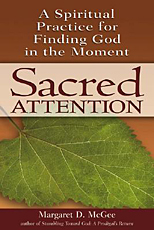"When my church offered a class in lectio divina — the ancient monastic practice of reading scripture aloud, followed by reflection, prayerful engagement, and contemplation — I hoped to learn another tool to help me along the path.
"But unlike serving as lector, the practice of lectio divina felt awkward to me. I had trouble getting the hang of it. Not until lectio divina stumbled against a quite different tool for paying attention — not until lectio divina met haiku — did I find myself chatting along that path in a back-and-forth conversation with God.
"I learned lectio divina in a five-week course at St. Paul's. Each Wednesday night, after a simple supper of shared soup and bread, we practiced reading scripture out loud and listening for God's voice. We paid particular attention to the language in the passage, to the words and phrases that resonated in our hearts. We shared with each other how those words and phrases spoke to us at that moment in time. It was a slow process with lots of space for silence and repeated readings of the chosen passage. Our leader, a retired Presbyterian minister, encouraged us to practice lectio divina at home during the week between meetings.
"The idea behind lectio divina appealed to me. I know that words carry power, and that their power rises and falls with the tides of daily life. In the Wednesday-night meetings, I enjoyed listening to the voices of older folks who had spent a whole lot more time reading scripture than I had.
"But at home during the week, practice was rough. At my desk in the morning or in bed at night, I tried to slow down, to focus on individual words and let them sink in, but I just could not keep that speed reader in check. It was frustrating — and humbling — to realize that I did not have the patience to hook into the text without the bait of a live audience to come.
"Then the following winter, I took a poetry class that included a session on writing haiku. Haiku is a Japanese verse form known for distilling the essence of a moment through strong nature imagery. For the class, the teacher brought in a few objects from nature — a flower, a branch, a stone — and had us choose one, then spend time looking at it and jotting down all the descriptive words and images that came to us. From those jottings, we picked one or two words to begin writing a haiku: a single verse with three lines of five, seven, and five syllables.
"It was much easier to slow down and pay attention to a stone than to a passage of scripture. Unlike my grade school teacher's reading competitions, our poetry teacher did not turn the exercise into a race. Instead, we were told to take our time. It worked. I wrote a bunch of haiku and had fun doing it.
"And the next time I tried lectio divina, something clicked over. Suddenly, I was able to see the scripture passage the same way I saw the stone: not as a chance to win another race, but as something worth spending time on for its own sake. Reading the passage, then reading it again, I paid attention to individual words and phrases as if they were fissures and bumps in a stone. The process felt natural and true. The haiku that came in response also felt natural and true. After writing my haiku, I went back and read the scripture passage one more time. The words on the page had not changed, but my relationship to them had been transformed. I copied my haiku onto a little yellow sticky note and pressed it onto the page next to the passage.
"Today, my Bible is filled with little yellow stickies, each containing its own haiku. Some draw out a theme from a verse or passage. Some argue back. Some use a word from the passage to take off in a completely different direction. Others express a realization about my own spiritual life that the passage inspired. When I leaf through my Bible, there they are, my own personal running conversations with God.”
